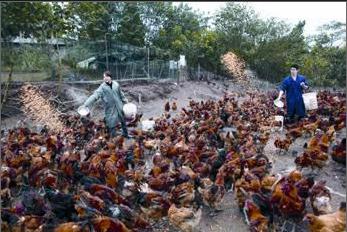Green Animal Farming
2014-03-18ByTangYuankai
By+Tang+Yuankai

As people hoarded meat for their Chinese Lunar New Year feasts in late January, livestock and poultry farms in Feixi County, east Chinas Anhui Province, were very busy. However, what occupied them was not increasing production, but preparing for moving and tackling pollution.
Feixi is home to more than 530 livestock and poultry producers. Traditionally, the Chinese Lunar New Year, which fell on January 31 this year, has been a time for them to relax and happily count the money from the surging meat sales that occur in the days leading up to the holiday.
But this year, they were not in the mood for celebration after the release of the countys zoning plan on large-scale livestock and poultry breeding in November 2013.
According to the plan, Feixis 1,960-squarekm land will be divided into zones where livestock and poultry production are permitted, restricted or banned. The plan says that no farms dealing with livestock and poultry production are allowed near the countys drinking water sources. Even in the zones where such farms are permitted, they will be strictly monitored for their environmental impacts.
Feixis Environmental Protection Bureau required that existing farms in banned areas be closed and relocated by the end of 2014, while farms in restricted areas should begin to recycle and reuse waste in order to meet environmental standards by the end of this June. It also said that the environmental condition in permitted zones will be monitored, and permitted zones may be redefined as restricted or banned zones in the case of environmental deterioration.
“The plan takes into consideration both the protection of the environment and the long-term development of the animal farming industry,” said Mao Hongyou, manager of Feixi County Zhengjia Boar Co. Ltd.
The companys farm occupies an area of about 1 hectare. “The farm has an annual output capacity of more than 20,000 pigs, and produces more than 100 tons of waste daily, including about 100 tons of urine and other waste water,” Mao said.
So far, Zhengjia Co. has invested 3 million yuan ($494,000) in pollution control. It is constructing a waste treatment facility that can handle 200 cubic meters of waste daily. The company also makes organic fertilizer from pig manure and sells it to offset the pollution control costs.
Feixi produced the plan in an effort to implement the State Councils Regulations on the Prevention and Control of Pollution Caused by Large-scale Breeding of Livestock and Poultry, which went into force on January 1.endprint
The regulations are said to be the first of its kind in the country to address pollution in rural areas. It bans livestock and poultry production near drinking water sources, scenic spots, core and buffer areas of nature reserves, residential areas and other densely populated areas.
Source of pollution
It is no surprise that Chinas 1.3 billion people have produced shocking amount of pollut- ants, yet many people are unaware of the heavy pollution from livestock and poultry production.
According to a technical guideline for pollution prevention and control in livestock and poultry production released by the Beijing Guohuan Tsinghua Environment Engineering Design and Research Institute, the number of pigs, oxen, goats and other animals raised in China is roughly equal to the countrys population. Studies show that a pig can produce the same amount of waste water as seven people, and the waste discharged from a large-scale livestock farm is no less than that from a medium-sized industrial plant, the document reveals.
In places such as Feixi, some large-scale animal farms are located near reservoirs and densely populated areas, and they discharge untreated pollutants into ecologically fragile areas, polluting the surrounding water, soil and air as a result.
In many places, agriculture rather than industrial production is the major source of water pollution. Furthermore, overuse of fertilizers and pesticides in livestock and poultry production has become the primary source of agricultural pollution.
In 2010, the discharge of chemical oxygen demand, nitrogen and phosphorus from livestock and poultry accounted for 41.9 percent, 21.7 percent and 37.7 percent of the national total, respectively. They also made up 96 percent, 38 percent and 65 percent of the total discharge from agricultural sources, according to the first national census on pollution released by the Ministry of Environmental Protection, the Ministry of Agriculture and the National Bureau of Statistics.
“Chinas livestock and poultry production sector lacks necessary guidance and planning. It has developed randomly to meet market needs, and as a result, the livestock and poultry production in some regions has exceeded the areas environmental carrying capacity,” said Jin Jianming, former chief engineer of the State Environmental Protection Administration, which is currently known as the Ministry of Environmental Protection.
Due to a lack of pollution treatment facilities, a large amount of manure and liquid waste is not effectively treated or used, leading to the need for environmental protection, Jin said. He warned that environmental problems caused by livestock and poultry production have become a significant impediment to the healthy development of the industry.endprint
Last March, dead pigs discarded by animal farms were found drifting in Shanghais Huangpu River. The scandal put pollution originated from the animal husbandry industry under public scrutiny, and indirectly sped up the making of a national pollution tackling regulation.
Stronger regulation
The Regulations on the Prevention and Control of Pollution Caused by Large-scale Breeding of Livestock and Poultry was promulgated to promote the sustainable development of the livestock and poultry production, Jin said.
The document spells out requirements for where animal farms are allowed to be situated, as well as for their waste disposal and recycling. Environmental impact evaluation is also required.
“We must pay equal importance to environmental protection and the development of the animal husbandry industry,” said Yang Zhengli, a research fellow with the Institute of Environment and Sustainable Development in Agriculture.
The regulations require that governments at or above the county level should make plans on preventing and controlling pollution generated by livestock and poultry production at the same time as they make the industrys development plan. Their industry development plans should take the environmental carrying capacity as well as pollution prevention and control into consideration.
While enhancing supervision over environmental impacts of the industry on the whole, the government will subsidize the construction of facilities for pollution prevention and control and the comprehensive utilization of waste, according to the document.
It stipulates that county-level governments can reward animal farms that voluntarily conform to pollution control standards stricter than those of the national and local governments.
The regulations state that enterprises producing organic fertilizers from their animal waste can enjoy preferential tax treatment, while purchasers and users of organic fertilizers shall be given subsidies no less than that given to purchasers and users of chemical fertilizers.
Animal waste is a valuable and useful resource, which can be used to produce biogas and organic fertilizers, said Dong Renjie, a professor at the Beijing-based China Agricultural University. He added that proper use of organic fertilizers can increase the concentration of organic matters in soil and increase soil productivity.endprint
Yet in the past, due to the lack of necessary legal support and effective policy incentives, a large amount of agricultural waste such as animal manure had not been effectively used, but instead posed environmental hazards to the surrounding water and soil.
Moreover, the regulations state that power grid companies should purchase surplus electricity generated from animal waste as long as the electricity meets the technical standards necessary for it to be fed into the grid. Companies producing methane and biogas from animal waste can also enjoy preferential tax treatment similar to renewable energy producers.
“The regulations encourage the comprehensive utilization of waste, and deems it the fundamental solution to tackling pollution arising from livestock and poultry production,” said Yang Zhengli, a research fellow with the Institute of Environment and Sustainable Development in Agriculture under the Chinese Academy of Social Sciences.
In foreign countries with tough environmental legislation such as Denmark, manure from farms has been collected and used as agricultural fertilizer growing crops.
It is not only waste that can be used, but also animal byproducts, according Karoline Bergendorff, a business development strategist at the Danish company Kopenhagen Fur.“In this way, the entire animal is used,” she said.
While the regulations will promote the improvement of rural environment, it will also raise the threshold to enter the industry. Industry experts believe that after the implementation of the regulations, large-scale animal farms with sound environmental protection facilities will be able to further consolidate their market position.endprint
